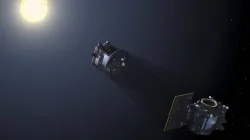The Indian Space Research Organisation (ISRO) is preparing to launch an exciting mission in collaboration with the European Space Agency (ESA) called Proba-3. This mission consists of two spacecraft that have been successfully arranged for launch at the Satish Dhawan Space Centre in India. Proba-3 is special because it will be the first mission ever to fly two spacecraft in a precise formation, allowing scientists to study the Sun’s atmosphere, known as the solar corona, in new and groundbreaking ways.
The two spacecraft involved are called the Occulter Spacecraft (OSC) and the Coronagraph Spacecraft (CSC). The OSC will sit on top of the CSC during the launch, and soon they will be prepared for their journey by filling the CSC with a special fuel needed for its movements in space.
The launch is scheduled for December 2024, with ISRO's PSLV-XL rocket set to carry them into orbit. Once in space, the two spacecraft will separate but will work together in a coordinated way, effectively forming a large tool to observe the Sun's faint corona. This setup promises to give scientists a closer look at solar activity than ever before, potentially leading to new discoveries about our Sun.
The mission will take the spacecraft on a unique path that allows them to make extended observations when they are farthest from Earth. This special orbit will help them gather valuable data while they are in space.
In other news, recent research suggests that Mars' moons, Phobos and Deimos, might have formed from debris left over when an asteroid was pulled apart by Mars' gravity. This study, published in the scientific journal Icarus, challenges previous ideas and helps explain why these moons look so unusual.
Unlike most moons, which are generally round, Phobos and Deimos have irregular shapes that resemble potatoes, and they orbit Mars in a near-circle. These strange characteristics have puzzled scientists for a long time, leading them to create new models to better understand how these moons came to be.
ALSO READ: SpaceX's sixth Starship mission partially successful, booster explodes in the ocean

